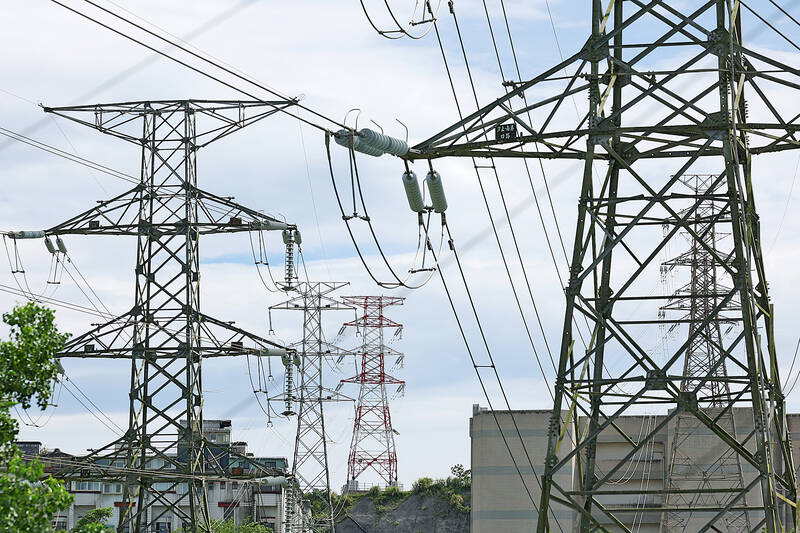Taiwan’s industrial electricity consumption last month rose 1.12 percent year-on-year, fueled by surging demand from artificial intelligence (AI) applications and next-generation consumer electronics, the Taiwan Research Institute (台綜院) said yesterday.
The New Taipei City-based institute, which publishes the electricity prosperity index (EPI) to gauge the health of industrial sectors, reported that the index flashed “yellow-red,” indicating a thriving state despite mounting disparities across industries. The reading reflects robust activity in technology-related sectors, even as traditional industries face headwinds.
Taiwan’s semiconductor sector continued its remarkable growth, with electricity consumption for the industry climbing 9.53 percent year-on-year and reaching a record high, the institute said.

Photo: CNA
The EPI’s electricity activity index for the sector has signaled strong demand with a red light for five consecutive months, underscoring the sustained expansion of the semiconductor industry.
Taiwan is home to the world’s largest supplier of advanced chips used in AI and high-performance computing, a position that continues to bolster industrial energy demand, the institute said.
Firms in the computer, electronics and optical products sector also recorded strong growth, with electricity consumption up 5.59 percent, it said, linking the rise to AI and cloud server deployment, as well as the launch of new consumer electronics products.
Apple Inc’s unveiling of its latest-generation iPhones, iPods and Apple Watch earlier this month contributed to higher business activity at local suppliers of camera lenses, casings, display panels, battery packs and other components, it added.
This increase occurred despite the recent implementation of US reciprocal tariffs, highlighting the resilience of Taiwan’s tech manufacturing ecosystem, the institute said.
Overall high-voltage electricity use across Taiwan edged up 0.6 percent from a year earlier, with the manufacturing sector up 0.31 percent and service providers up 1.41 percent, it said.
However, not all sectors experienced positive developments. Electricity consumption fell 9.41 percent at local steelmakers, dropped 16.37 percent at textile firms and declined 11.96 percent at machinery tool vendors.
Rising production costs due to Taiwan’s environmental policies and global shifts toward greener chemicals have placed additional pressure on chemical product manufacturers.
Moreover, China, previously a major importer of Taiwanese chemicals, has expanded its domestic production, reducing demand for imports from Taiwan.
The institute expects the ongoing AI boom to continue fueling growth in the semiconductor sector, helping to offset downturns in non-tech industries and supporting the overall economy.
At the same time, the institute said that Taiwan must carefully monitor global economic uncertainties, including potential US tariff threats, to mitigate downside risks to local industries.

Taiwan’s long-term economic competitiveness will hinge not only on national champions like Taiwan Semiconductor Manufacturing Co. (TSMC, 台積電) but also on the widespread adoption of artificial intelligence (AI) and other emerging technologies, a US-based scholar has said. At a lecture in Taipei on Tuesday, Jeffrey Ding, assistant professor of political science at the George Washington University and author of "Technology and the Rise of Great Powers," argued that historical experience shows that general-purpose technologies (GPTs) — such as electricity, computers and now AI — shape long-term economic advantages through their diffusion across the broader economy. "What really matters is not who pioneers

In a high-security Shenzhen laboratory, Chinese scientists have built what Washington has spent years trying to prevent: a prototype of a machine capable of producing the cutting-edge semiconductor chips that power artificial intelligence (AI), smartphones and weapons central to Western military dominance, Reuters has learned. Completed early this year and undergoing testing, the prototype fills nearly an entire factory floor. It was built by a team of former engineers from Dutch semiconductor giant ASML who reverse-engineered the company’s extreme ultraviolet lithography (EUV) machines, according to two people with knowledge of the project. EUV machines sit at the heart of a technological Cold

TAIWAN VALUE CHAIN: Foxtron is to fully own Luxgen following the transaction and it plans to launch a new electric model, the Foxtron Bria, in Taiwan next year Yulon Motor Co (裕隆汽車) yesterday said that its board of directors approved the disposal of its electric vehicle (EV) unit, Luxgen Motor Co (納智捷汽車), to Foxtron Vehicle Technologies Co (鴻華先進) for NT$787.6 million (US$24.98 million). Foxtron, a half-half joint venture between Yulon affiliate Hua-Chuang Automobile Information Technical Center Co (華創車電) and Hon Hai Precision Industry Co (鴻海精密), expects to wrap up the deal in the first quarter of next year. Foxtron would fully own Luxgen following the transaction, including five car distributing companies, outlets and all employees. The deal is subject to the approval of the Fair Trade Commission, Foxtron said. “Foxtron will be

Taiwan Semiconductor Manufacturing Co (TSMC, 台積電) last week recorded an increase in the number of shareholders to the highest in almost eight months, despite its share price falling 3.38 percent from the previous week, Taiwan Stock Exchange data released on Saturday showed. As of Friday, TSMC had 1.88 million shareholders, the most since the week of April 25 and an increase of 31,870 from the previous week, the data showed. The number of shareholders jumped despite a drop of NT$50 (US$1.59), or 3.38 percent, in TSMC’s share price from a week earlier to NT$1,430, as investors took profits from their earlier gains